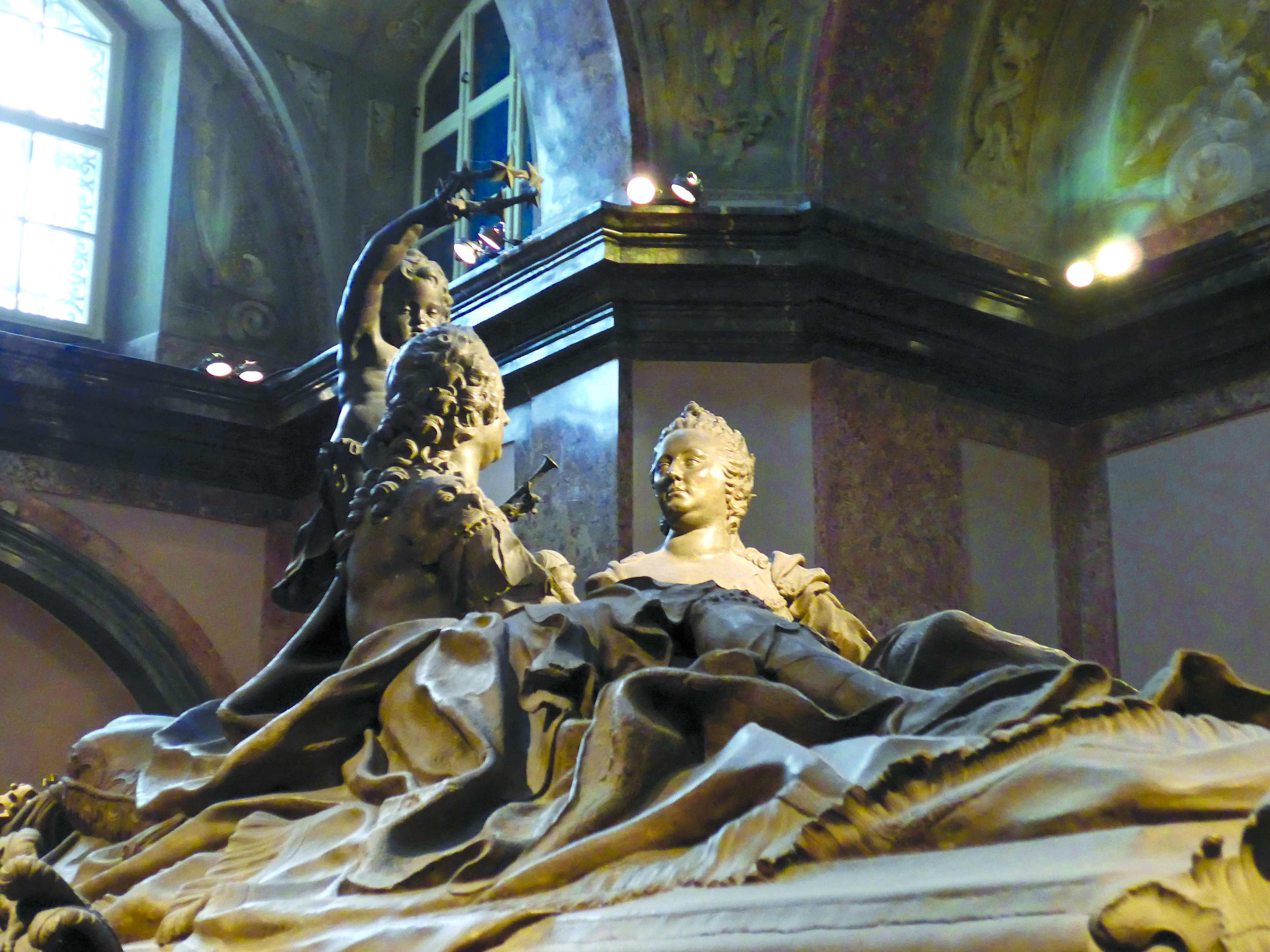
Two identical figures of Empress Maria Theresa rise from her tomb, depicting her resurrection, in the crypt of the Capuchin Church in Vienna. The sarcophagus, which fills an entire room, was completed 30 years before her death. (CNS/Zita Ballinger Fletcher)
Few people would suspect that the order of Capuchin monks, famous for their humble imitation of St. Francis, are special guardians entrusted with the duty of caring for Austria's imperial crypt.
The Capuchin Crypt (Kapuzinergruft) lies beneath a tiny Franciscan church in Vienna. Beneath the simple wood-furnished church is a vast labyrinth of tunnels and chambers, filled with elaborate metal sarcophagi. The coffins hold the remains of 150 royal family members of the Habsburg dynasty. The Capuchins have continuously cared for the crypt and the sarcophagi, despite the collapse of the monarchy and two world wars.
"The friars are supposed to pray for the deceased and preserve the burial place," Peter Grubits, manager of the crypt, told Catholic News Service. Grubits has been manager of the crypt since 2011, a duty he describes as an honor.
Caring for the tombs became a duty of the Capuchins in 1618, when Empress Anna of Tyrol's last will asked the friars to pray for the royal family and the nation. Empress Anna chose the Capuchins due to familiarity with them and their popularity with ordinary people. Later in the 1600s, Emperor Ferdinand III decided to bury all royal family members under the church.
"The Habsburgs always have been loyal Catholics. This was part of the legitimation of their claim to power," said Grubits, explaining that Catholicism was required for leaders of the Holy Roman Empire.
The sarcophagi are made of alloys of different metals. The designs depict ornate and fantastic people and stories, including skulls in royal crowns and veiled figures. Most designs mingle symbols of glory and empire with symbols of humility and death.
"On one hand, the Capuchin Crypt and its sarcophagi are monuments of faith. The Habsburgs knew themselves to be sinners. This is shown by the variety of symbols of death and vanity," said Grubits.
Some Habsburgs designed their tombs well in advance, and some sarcophagi are so huge that they had to be assembled on the spot.
One such marvel is the tomb of Empress Maria Theresa, who died in 1780. The immense coffin fills an entire room. On it, two identical figures of the empress gaze at each other as they rise from the grave, depicting the resurrection of her body and soul. The tomb was designed 30 years before her death.
"I am fascinated by the fact that issues of death and passing were not pushed in the back of the mind but were obvious and present," said Grubits.
In the past, royal burials were an elaborate ritual. Bodies of the royalty were embalmed and displayed in festive garments for at least three days in public. The nation was required to mourn. The entire city of Vienna was arrayed in the mourning color of black, with palaces, churches and important buildings draped in black cloth.
After a blessing from the archbishop of Vienna, a royal coffin was locked with two locks and reopened briefly. Then the coffin was sealed and keys were given to a royal steward and a Capuchin friar. Afterward, the wooden coffin was placed in an elaborate metal sarcophagus inside the Capuchin crypt.
The sarcophagi from modern times are much simpler. They follow the basic design of the coffin of Emperor Franz Joseph I, who died in 1916. Among the later burials are the last Empress Zita of Austria, who died in 1989, and her son, Otto. The decision to keep a tradition of simplicity is done partially for political reasons, said Grubits.
"This is to show respect for the democratic constitution of Austria and was a joint decision of the Habsburg family and the Capuchin friars," said Grubits.
Advertisement
The royal crypt survived World War II mostly intact. The windows were walled up, and sarcophagi were sheltered with pieces of wood. Although the monastery and church were unharmed by bombing, the room containing the coffin of Empress Maria Theresa suffered serious damage from bomb splinters. According to Grubits, the dignity of the crypt as a cemetery spared it from looting.
The Order of the Capuchin Friars became the official owner of the crypt in the early 1960s. Today, visitors to Vienna can wander the maze of underground chambers for a small fee.
"Nowadays the entrance fees of the visitors help to maintain the crypt and regularly restore the sarcophagi," said Grubits.
The Capuchin Church has never been a parish church, although it hosts regular Masses. It is famous in Vienna for its special focus on the sacrament of penance.
Grubits said he believes the personal stories of the deceased are the most important thing people can learn from visiting the royal crypt.
"You can pass almost 400 years of Austrian, European and even world history, of course of art history, too," he said. "But it is the personal destinies, the hopes, the failures, the tragedies that are touching," said Grubits.





